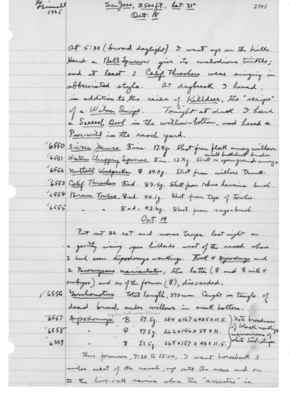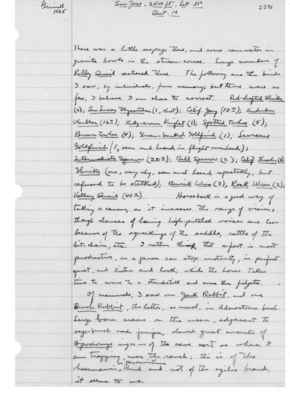Pages That Mention brown towhee
1925: Joseph Grinnell's field notes
S3 Page 52
Collector: Grinnell - 1925 Location: San Jose, 2500 ft., lat. 31 degrees Date: October 18, 1925 Page Number: 2595
at 5:30 (broad daylight) I went up on the hills. Heard a Bell Sparrow give its melodious tinkle; and at least 3 Calif. Thrashers were singing in abbreviated style. At daybreak I heard, in addition to the cries of Killdeer, the “scaipe” of a Wilson Snipe. Tonight at dusk I heard a Screech Owl in the willow-bottom, and heard a Poor-will in the ranch yard.
6550 Sierra Junco (male sign) im. 12.4g. Shot from flock among willows. 6551 Western Chipping Sparrow (male sign) im. 12.4.g. Shot in open ground among small buckwheat bushes. 6552 Nuttall Woodpecker (female sign) 34.0g. Shot from willow trunk. 6553 Calif. Thrasher (male sign) ad. 83.5.g. Shot from rhus laurina bush. 6554 Brown Towhee (female sign) ad. 40.1g. Shot from top of towhee. 6555 “ “ (male sign) ad. 43.6g. Shot from sage-bush.
Oct 19 Put out 22 rat and mouse traps last night on a gently rising open hillside west of the ranch where I had seen dipodomys workings. Took 4 Dipodomys and 2 Periomyscus maniculatus; the latter ((male sign) and (female sign) with 4 embryos) and one of the former ((male sign)), discarded.
6556 Gerrhonotus Total length, 370 mm. Caught in tangle of dead brush under willows in creek bottom. 6557 Dipodomys (male sign) 59.5g. 284 x 167 x 40.5 x 11.5. } Note broadness 6558 “ “ (female sign) 47.5g. 262 x 156 x 39 x 11. } of black markings, narrowness of 6559 “ “ (male sign) 51.5g. 265 x 157 x 40 x 11.5. } white tail-stripe. This forenoon, 7:30 to 12:00, I went horseback 3 miles west of the ranch, up onto the mesa and on to the live-oak ravine where the “arrastre” is.
S3 Page 53
Collector: Grinnell - 1925 Location: San Jose, 2500 ft., Lat. 31 degrees Date: October 19, 1925 Page Number: 2596
There was a little seepage there, and some rainwater in granite bowls in the stream-course. Large numbers of Valley Quail centered there. The following are the birds I saw, by individuals, from memory; but there were so few, I believe I am close & correct. Red-shafted Flicker (2); San Lucas Flycatcher (1, shot); Calif Jay (10±) Audubon Warbler (16±); Ruby-crown Kinglet (1); Spotted Towhee (5); Brown Towhee (4); Green-backed Goldfinch (1); Lawrence Goldfinch (1, seen and heard in flight overhead); Intermediate Sparrow (20±); Bell Sparrow (2); Calif. Thrashers (3); Shrike (one, very shy, seen and heard repeatedly, but refused to be stalked); Bewick Wren (3); Rock Wren (2); Valley Quail (40±). Horseback is a good way of taking a census, as it increases the range of vision, though chances of hearing high-pitched voices are less because of the squeakings of the saddle, rattle of the bit-chain, etc. I rather think that a foot in most productive, as a person can stop instantly, in perfect quiet, and listen and look; while the horse takes time to come to a standstill and even then fidgets. Of mammals, I saw one Jack Rabbit, and one Bush Rabbit, the latter, as usual in Adenostoma bush. Large bare areas in the mesa, adjacent to sage-bush and juniper, showed great amounts of Dipodomys sign — of the same sort as where I am trapping, near the ranch; this is of the heermanni or paramintinus kind and not of the agilis brand, it seems to me.
S3 Page 57
S3 Page 57
Collector: Grinnell - 1925 Location: San Jose, 2500 ft., lat. 31° Date: Oct. 21 Page Number: 2600
“This bear we will label for convenience Ursus Californiensis, because the title of Ursus Americanus has dignified the small black bear of the Eastern states.” Etc. This is surely a “good” scientific name and ought to be recognized, at least in synonymy. The status of this name in view of Merriam's (1896?) Ursus Californicus for a grizzly needs looking into!
I have just asked Mr. Meling about bears in Lower California. He says he has never heard that they were ever here; and the Indians have no knowledge of them. Badgers occur in all the valleys in one section; Meling has seen them here and in San Telmo Valley, as well as elsewhere. Ring-tailed Cats occur in the oak belt. He saw a skin taken at Concepcion, “about 4 miles up against the mountain from Socorro.” Coons are very common here, coming into the orchard and corn-fields; I have seen numerous tracks myself.
Striped Skunks are also common, but Spotted Skunks not known to Mr. Meling from this side “the mountain.” 6579 Russet-backed Thrush (female sign) im. 26.8g. Shot in willow. 6580 Alaska Hermit Thrush (male sign) im. 24.2g. “ “ “ 6581 Spotted Towhee (male sign) im. 36.5g. Shot in elder-berry. 6582 Brown Towhee (male sign) ad. 46.0g. in fat. Shot from sage-bush.
Oct. 22 Rained a good deal during the night. Still overcast; warm and sultry. Barometer, 27.20 inches. Annual vegetation in starting up everywhere, much to the stockmen’s joy.
S3 Page 59
S3 Page 59
Collector: Grinnell - 1925 Location: San Jose, 2500 ft., lat. 31° Date: Oct. 23 Page Number: 2602
6589 Thomomys (female sign) 123g. 207 x 58 x 29 x 5. In sandy bottom, where bermuda & salt grass grow. 6590 “ (female sign) 96g. 190 x 57 x 25 x 4. “ “ “ “ “ “
This forenoon I worked the washes and foothills north of the ranch one to two miles, against the lower range of mountains toward Socorro. In a broad shallow wash down west from those mountains found a well-marked yucca association: a kind of yucca, of stalks 6 to 8 feet high [= buccata?]; low clumps of cholla cactus, greasewood, sage-brush, some alder and rhus laurina bushes. Here I found the following birds: Shrike (one, perching from station to station in yucca tips on bare burned bush tips - too shy to approach closely enuf for a shot); Cactus Woodpecker(one, shot, on yuccas, calling characteristically, finally lit in a big desert tea bush); Black-tailed Gnatcatcher (one company of about 5, in buckwheat, greasewood and sage; kitten-like calls I now think quite like birds in Southern California; hard to see, and soon scattered and became quiet - lost); Ball Sparrow (few, about 6 all told, seemingly in pairs); Brown Towhee (2); Bewick Wren (2+); Say Phoebe (1); Intermediate Sparrow (commonest of the birds - perhaps all 25 told).
Then worked the willows down-stream from the ranch. Saw a Red-breasted and a Red-naped (shot) Sapsucker close together. Heard a Lawrence Goldfinch in flight overhead, as also a Green-backed Goldfinch. Saw one Russet-backed (?) Thrush.
S3 Page 66
Collector: Grinnell - 1925 Location: to Colnett, Sat. 31 degrees Date: Oct. 28 Page Number: 2608
6641 Savannah Sparrow (female sign) im. 16.7g. Shot in salicornia. 6642 “ “ (female sign) im. 16.8.g. Shot on stem of clump of juncus.
Was out early 5:15 to 6:30, and again 9:20 to 11:30, the last time to the beach, the bluff, and the salt flats. Saw following birds: Turkey Vulture (4+); Poorwill (heard calling last evening); Valley Quail (2 large coveys near camp); Cactus Woodpecker (one heard); Say Phoebe (2); Anna Hummer (2, around blossoming Lycium); Brown Towhee (4+); Spotted Towhee (2); Rufous-crowned Sparrow (2); Intermediate Sparrow (12±); Calif. Thrasher (2, singing); Linnet (6±); Wren-tit (4+); Black-Tailed Gnatcatcher (2); Bewick Wren (2); Red-winged Blackbird (a pair visited camp, and others in small companies in flight out in the valley); Raven (within hearing most of the time); Meadowlark (4 or more, out in salt flat); Marsh Wren (common, a dozen or more, in dense mats of Salicornia (unknown 1) sloughs just back of the cobble-stone beach-barrier (which is fully 8 feet higher than the flats inland from it)); Savannah Sparrow (scattered troupes on open ground among small bushes back from the salicornia); Belding and Large-billed Sparrows (on salicornia marshes, not many, the latter also on beach at high-tide line of drift); Pipit (flock of 10± on bare alkali flat); Killdeer (one heard - the only wader, where we saw so many on the beach when we were here in September); Song Sparrow (2, in big juncus clumps up the valley from the salicornia. Of mammals, I saw one Jack Rabbit on salt flat and 2 or more Brush Rabbits.




